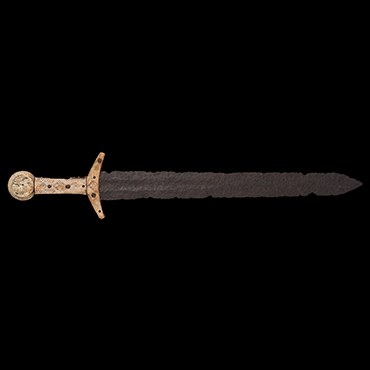A sword with a game
The round pommel on this sword is typical of its period: swords from this period usually had a large pommel at the end of the hilt to help counterbalance the weight of the blade. What makes this sword unusual is that the hilt and pommel are made of ivory. The design of this pommel is similar in style to a group of tablemen (games-pieces) which are thought to have been made in the 6th and 7th-centuries AH/12th and 13th-centuries CE northwestern Europe. The border surrounding the quillons, grips, and pommel is identical to that found on many tablemen attributed to the “Pricked Ivories Workshop,” which is believed to have been based in Cologne. The best-known group of these ivories, now housed in the British Museum, has animals occupying the roundels on each side, as seen here. It is almost as if the patron of the sword had one particularly lucky tableman, which he requested to be incorporated into the hilt of his new sword. The quillons also support a German origin; they appear on a bronze aquamanile attributed to Hildesheim around 1300 which may depict Edmund Crouchback, Earl of Lancaster and King of Sicily.
The sword is shorter than was normal at the time and was almost certainly reduced in length. Other swords of the same period are generally between 80–110 cm long.
This sword is most likely of German origin, but it has links to Sicily and to the Islamic world. The games of backgammon and tables, the forerunner of checkers, are both thought to have spread to Europe from the Islamic world, and around the time this sword was made, Frederick II Hohenstaufen (r. AH 1197–1250 CE) was the ruler of Germany, Italy, Sicily, and nominal King of Jerusalem. He was the leader of the sixth Crusade which captured Jerusalem for Christian forces. His sarcophagus was opened in the 18th century, uncovering an alb (white under-vestment) inscribed on the border with Arabic royal titles in thuluth.
A sword with a game
Sword
Germany or possibly Italy, late 6th or early 7th century AH /late 12th or early 13th century CE
Steel, forged; Ivory, drilled and carved; copper rivets, l. 61 cm
Furusiyya Art Foundation, R-1125

